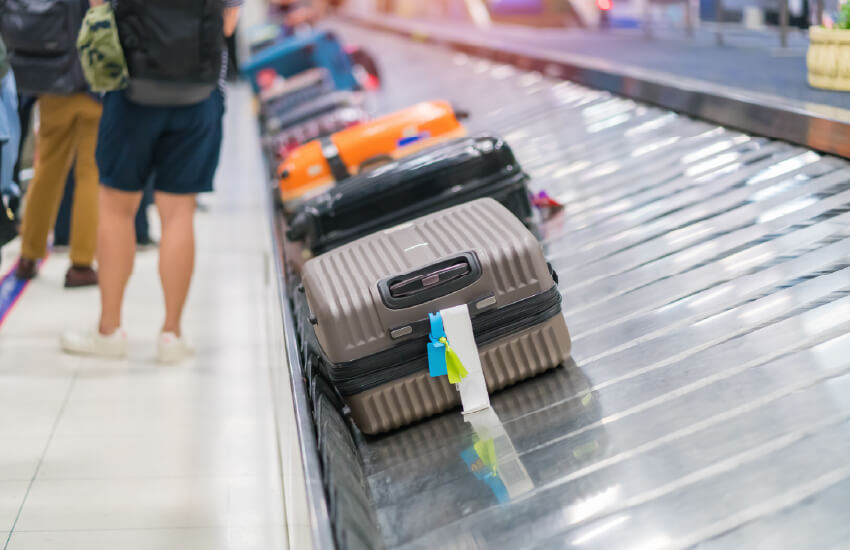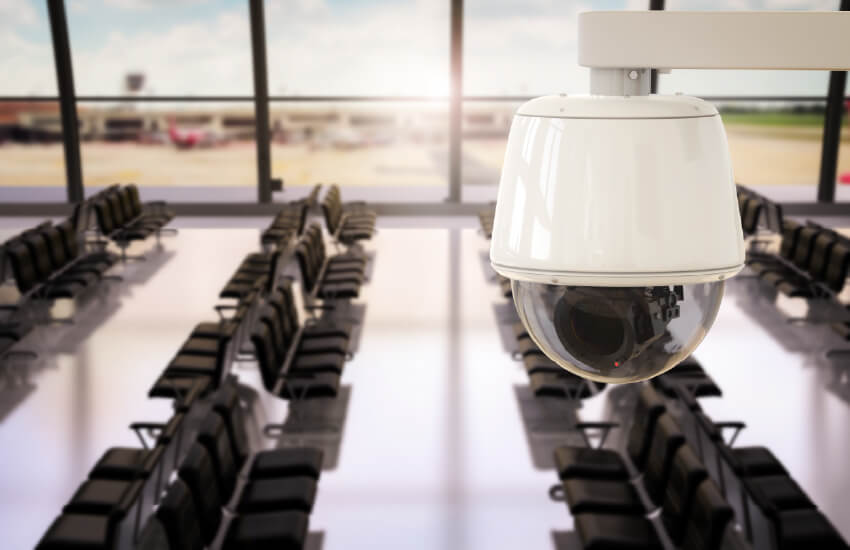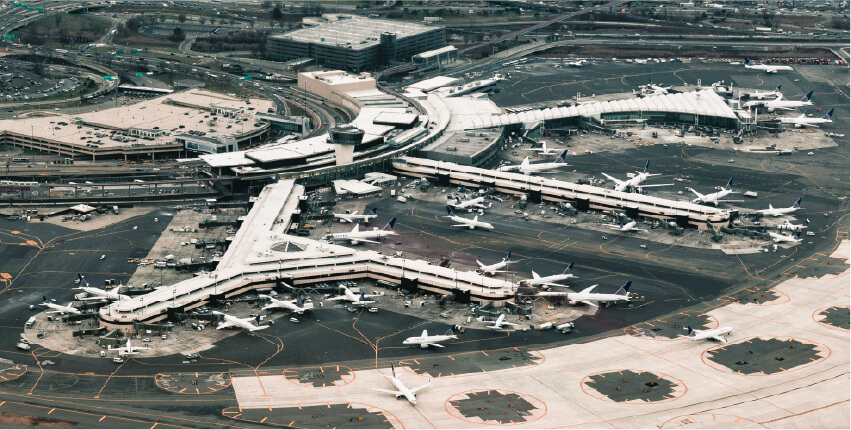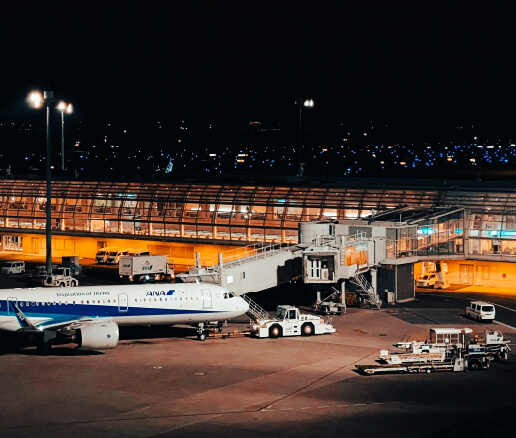by Webbing Team | June 25, 2025
When we think about connectivity at airports, it’s often in the context of passenger experience, such as ensuring travelers can stream Netflix or scroll social media while waiting for their flights. But the role of connectivity goes far beyond keeping passengers entertained. Today’s airports are complex IoT-enabled ecosystems filled with thousands of connected devices, from smart baggage systems and biometric gates to surveillance cameras and automated ground equipment. Airline operations also depend heavily on reliable connectivity, including flight scheduling and aircraft maintenance. In many ways, the digital infrastructure running behind the scenes is just as critical as the runways themselves.
As airports become increasingly dependent on connectivity to support both daily operations and a growing number of mission-critical applications, their demand for a more reliable and capable network has surged. Traditional Wi-Fi infrastructure, while sufficient for basic needs, falls short in several key areas. First, it struggles to provide consistent and reliable coverage across vast territory spanning terminals, runways, baggage halls, hangars, and outdoor areas. Second, network congestion is a constant concern: with thousands of connected devices and high user density, Wi-Fi often becomes overloaded, which leads to dropped connections and unstable performance. Security poses another challenge: Wi-Fi typically uses shared access points and passwords, making it more susceptible to breaches. Additionally, as airports expand their digital infrastructure, Wi-Fi lacks the scalability and device density support required to manage thousands of continuously connected endpoints. These limitations have led many airports to adopt private cellular networks as a future-proof alternative.
Cellular connectivity also plays a vital role in streamlining airline operations, especially on the ground where speed and coordination are essential. From the moment an aircraft touches down, dozens of tasks need to happen in a tightly orchestrated sequence: baggage unloading, refueling, technical checks, catering, cleaning etc. Cellular networks, particularly private LTE/5G, enable real-time communication between all ground teams involved. With mobile devices and connected equipment operating over a secure cellular link, teams can receive updates instantly and report issues without delays.
Cellular technology is not only transforming aviation through real-time coordination and automation but also lays the digital foundation for smarter and safer air travel. Let’s look at the key use cases and see how airport and airline operators can benefit from using cellular networks:

Real-Time Crew Communications
Airlines rely on cellular connectivity to support crew communications. Instead of using outdated radios or Wi-Fi which may have dead zones, flight and ground crews can use push-to-talk apps and mobile VoIP on smartphones and rugged tablets, to guarantee constant communication regardless of their location on the tarmac or in the terminal.
One of the challenges here is that since several carriers cover the same airport, airlines seeking continuous connectivity must manage multiple relationships with different carriers across various countries to achieve the necessary coverage. This results in higher costs and more portals to manage and maintain. One of Webbing’s clients, a well-known commercial airline that serves 350 destinations in more than 50 countries, uses our global cellular connectivity to allow their operations to function seamlessly. For example, their pilots often need to change the flight plan or alter fuel levels and therefore need to be connected at all times. Without online access, the process has to be carried out manually over a call. Webbing’s solution ensures the airline’s 26 000 tablets stay reliably connected everywhere they operate, while also offering the best rates through a single supplier and eliminating the complexity and overhead of managing multiple carriers and billing systems.

Baggage Handling
Automated baggage systems increasingly rely on connected conveyor belts and scanners that must report real-time status and alerts. Cellular networks allow for uninterrupted communication between these systems and backend platforms. Additionally, connected tags or tracking devices on luggage and cargo benefit from reliable mobile coverage, reducing loss and delays. Reliance on barcode technology over the years has resulted in a significant amount of mishandled baggage. Today, many airports implement RFID technology that is expected to reduce mishandling rates by 25%, and RFID systems can significantly benefit from private 5G networks.
Cellular technology also enables other use cases that can transform smart baggage systems. For example, Hong Kong International Airport, the world’s busiest international cargo hub, is set to launch the city’s first air cargo terminal powered by a 5G private network. This new 5G private network will lay the groundwork for the adoption of cutting-edge technologies, such as Autonomous Electric Tractors (AETs) which transport cargo around the terminal.
Airside Operations and Ground Support Equipment (GSE)
Cellular-connected systems can transmit diagnostics and performance data from aircraft systems to airline IT and maintenance teams as soon as the plane lands. This helps speed up inspections and enables predictive maintenance, identifying potential issues before they cause delays.
Cellular networks also enable real-time tracking and coordination of vehicles and equipment such as fuel trucks or de-icing units that move across wide outdoor areas where Wi-Fi is limited or unreliable. With cellular-connected sensors and telematics, airports gain precise location data and maintenance alerts, which helps to ensure smoother turnaround times and reduce operational delays.

Video Surveillance and Perimeter Security
Modern airport security systems depend heavily on high-definition cameras and intrusion detection sensors spread across terminals and perimeter fencing. Oftentimes airports also use drones for remote inspections and aerial monitoring. All these devices need high bandwidth and low-latency connectivity to stream video and trigger alerts. Cellular networks, especially private 5G, support these needs, without the need for costly wired infrastructure.
Security applications are among the strongest use cases driving private cellular network adoption in airports. For instance, the Croatian airports of Zagreb and Pula are set to deploy private 5G networks to improve security. At Zagreb, a drone with a UHD camera and AI analytics will inspect 188,000 sqm of runway and 14 km of fencing, enabling real-time issue detection. Pula will deploy 50 UHD cameras and sensors for perimeter monitoring. Other airports, like the previously mentioned Hong Kong International, have even deployed AI-powered security robots connected via cellular networks, which patrol cargo areas and transmit live video feeds for threat detection and response.

Connectivity Requirements for Airports and Airlines
Coverage
Cellular coverage is critical for smart airports because it provides consistent connectivity across vast areas that Wi-Fi networks struggle to reach. Strong coverage ensures that everything from baggage tracking and security surveillance to ground crew coordination and autonomous equipment can stay connected no matter where they are on the premises. However, to mitigate potential coverage gaps or signal interference, it is important that devices can connect to multiple networks in the area.
Seamless Connectivity
Seamless connectivity is as important as access to multiple networks. For drones and autonomous vehicles, the capability of switching between different mobile carriers’ networks without losing connection is a critical feature. It is also essential for devices that need to move between private and public networks, or use public network as a backup if their connection to the private network is lost.
Latency
Low latency is critical for many mission-critical applications that airports use, like autonomous vehicles, drone surveillance, or predictive maintenance. Cellular networks typically offer lower latency than other wireless technologies, with 5G capable of delivering response times as low as 1 millisecond, though actual performance depends on the architecture of the connectivity provider’s core network.
Scalability
Scalability is essential for airports because the number of connected devices, from sensors and cameras to vehicles and handheld terminals, is constantly growing. Cellular networks are specifically designed to handle high device densities, enabling airports to expand their IoT infrastructure without performance degradation. Unlike Wi-Fi, which struggles as more endpoints are added, cellular connectivity can support thousands of simultaneous connections across large areas. That said, some use cases may have specific technical requirements that depend on how your provider’s core network is configured.
Security and Compliance with Connectivity Regulations
Airports handle massive volumes of sensitive data, and any breach could lead to service disruptions, or even threats to public safety. Cellular networks, particularly private ones, offer advanced security features like SIM-based authentication, traffic isolation, and encrypted communication that are harder to compromise than traditional Wi-Fi. Moreover, airports are considered critical infrastructure and must comply with national and international regulations on data privacy and sovereignty. Ensuring secure and compliant connectivity is not just a best practice, but a regulatory requirement, and therefore your connectivity solution’s flexibility in that regard is also critical.

Webbing’s Connectivity Solution for Airports and Airlines
Webbing offers a connectivity solution that ensures global access to reliable and high-quality internet, with low latency and the best of class coverage. It provides secure and continuous internet connection for all types of devices used by airline and airport operators, anywhere in the world.
Webbing’s partner network of over 600 mobile operators worldwide guarantees global coverage. It allows to roam on several carriers’ networks in every region, solving the problem of weak spots that any mobile network may have and ensuring full coverage and continuous connectivity even at remote locations.
Webbing is a global connectivity provider with a distributed full core network with local breakouts, multiple network solution, and data server redundancy that provides connectivity stability and low latency. As such, Webbing’s network allows for realization of most complex scenarios with different types of devices, high-data consumption and industry-specific requirements. It also allows for all types of localization, making it easy to comply with local regulation requirements even in heavily regulated markets.
Our eSIM solution guarantees failover connectivity with the capability of using multiple mobile carrier profiles, easily changing carriers at any time with zero integration, and an option to fall back from a failing profile to a different profile without any need to communicate with a remote server or deal with multiple SIM cards. It helps enterprises that need access to private and public networks to ensure continuous data connectivity for their devices. Easily set business rules help determine automatic profile allocation and enable fallback mechanisms in case of private network failure or coverage issues.
A flexible approach to data packages allows us to tailor our connectivity offering for every customer based on the type of connected devices and their data consumption needs as well as the locations where the devices are used, aiming at overall optimization of the total cost of operations for the client.
Our solutions help enterprises overcome their connectivity challenges and optimize costs for global IoT deployments, providing the benefits of roaming with multiple carrier options in every country, and seamless transition between carriers, public and private networks, while maintaining low rates and low latency on a global scale with a single SIM.
Reach out today to learn how Webbing can support your airport or airline with reliable, scalable, and secure cellular connectivity.




